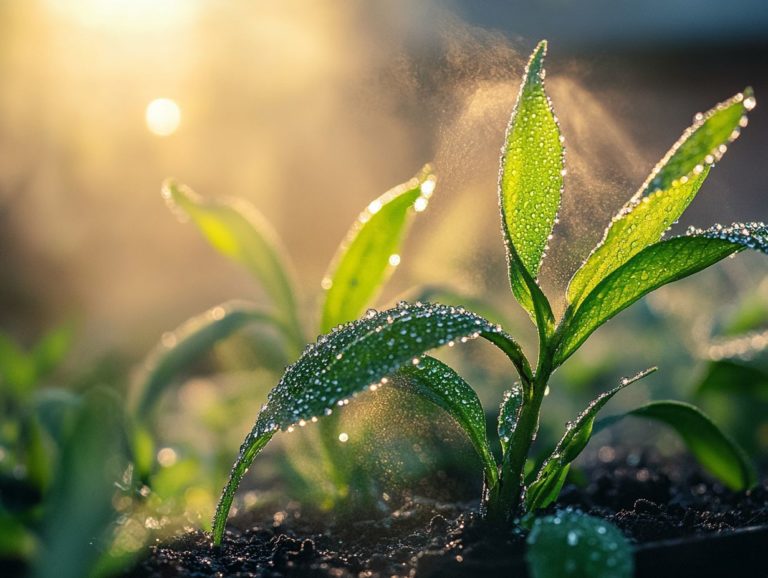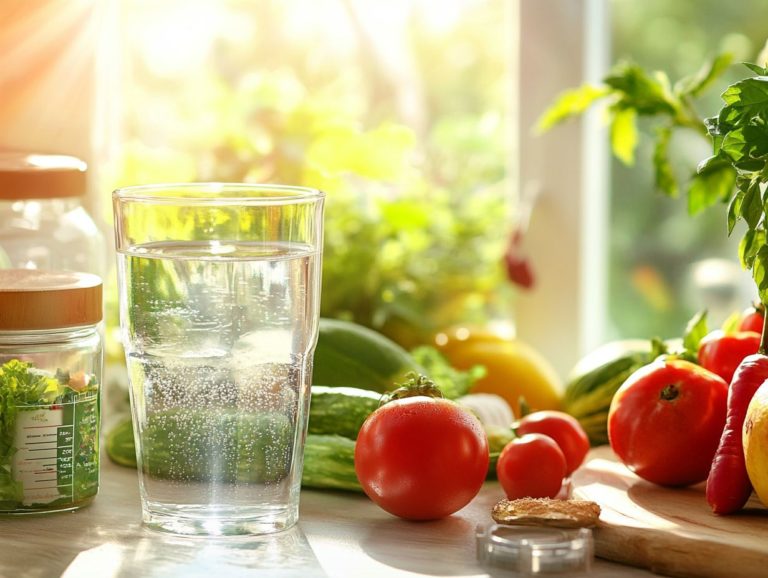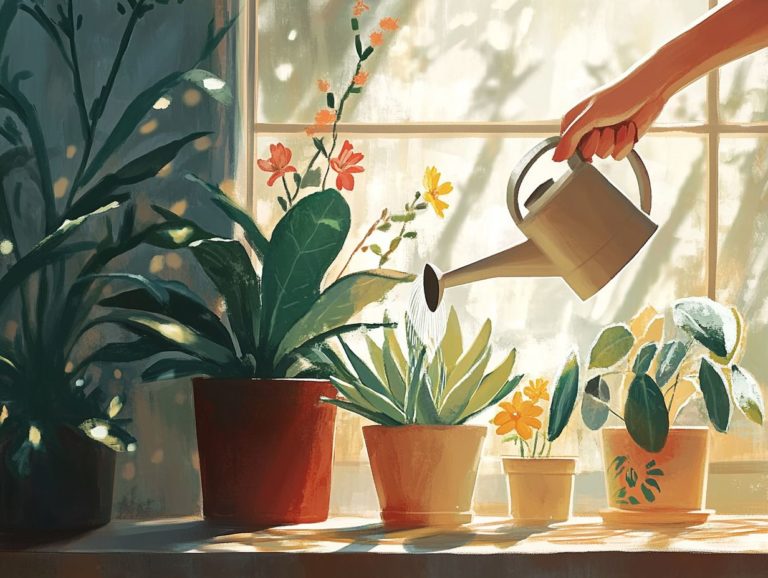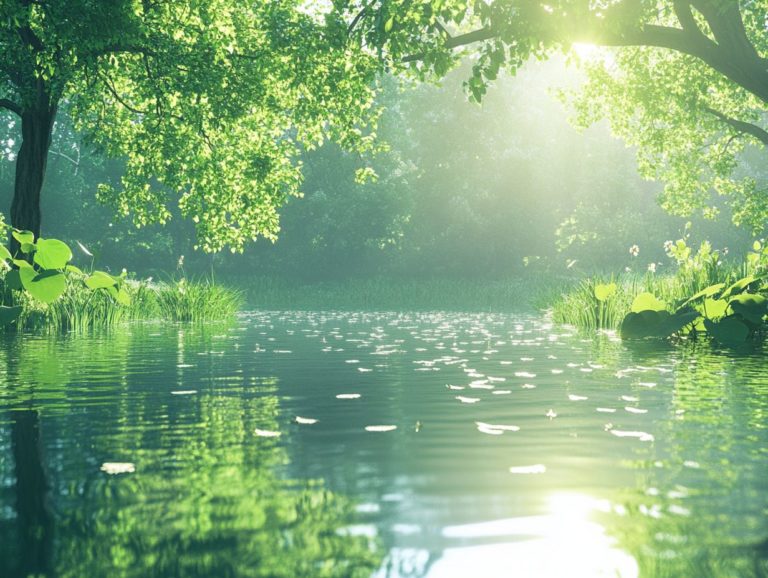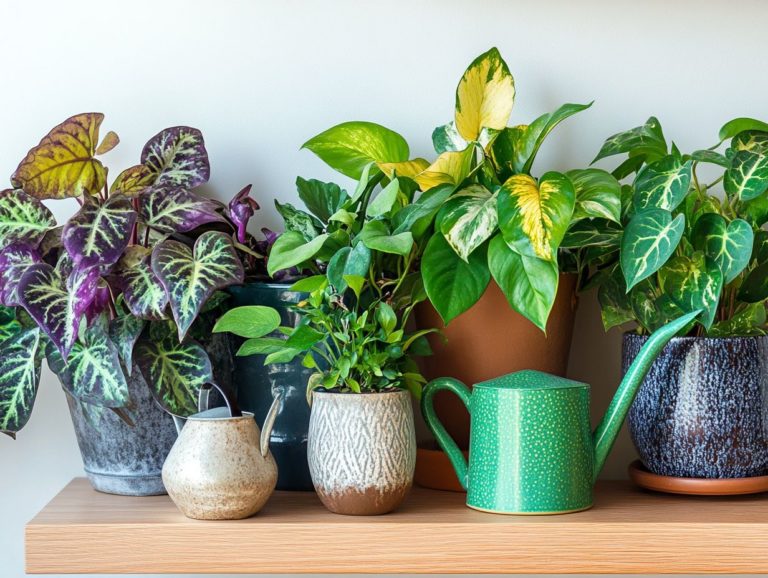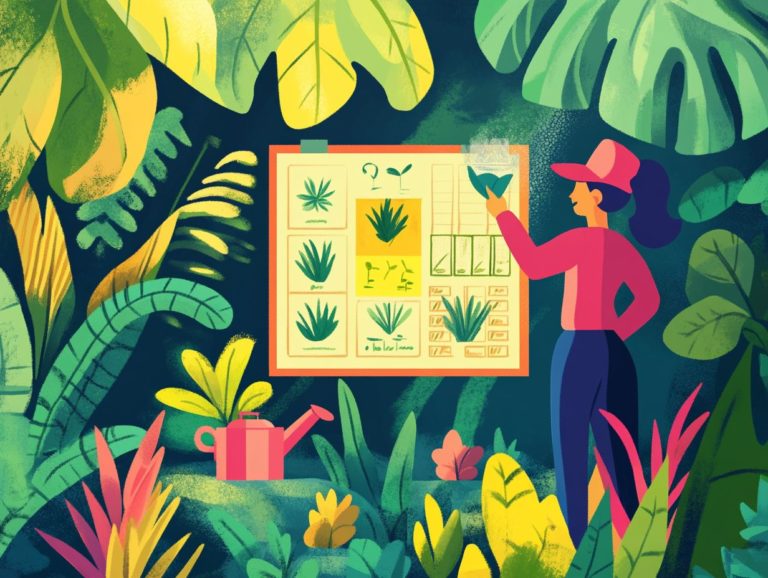The Impact of Pot Size on Watering Needs
Selecting the right pot size for your plants, including options like ceramic pots and plastic pots, can profoundly impact their overall health and growth.
Understanding how pot size affects your plants is key to better gardening. The connection between pot size and watering frequency is essential for any dedicated gardener.
This guide delves into how various pot sizes, including container size and pot shape, influence watering needs. It provides insights on choosing the perfect pot for your plants and shares best practices for effective water management techniques.
By tackling common pitfalls such as overwatering and underwatering, you’ll learn how to strike the ideal balance for your beloved green companions, ensuring their root systems remain healthy.
Contents
- Key Takeaways:
- How Pot Size Affects Watering Needs
- Choosing the Right Pot Size for Your Plants
- Watering Techniques for Different Pot Sizes
- Common Mistakes to Avoid
- Frequently Asked Questions
- How does the size of a pot affect the watering needs of a plant, including aspects like drainage holes and water retention?
- What is the recommended pot size for indoor plants and those with high watering needs?
- Do different types of plants, like succulents versus annuals, have varying watering needs based on pot size?
- Can using the wrong pot size, such as plastic pots versus ceramic pots, affect the health of a plant?
- Are there any other factors, such as temperature impact or soil types, that can affect watering needs besides pot size?
- How can I tell if my plant needs to be watered based on the pot size and moisture control techniques?
Key Takeaways:
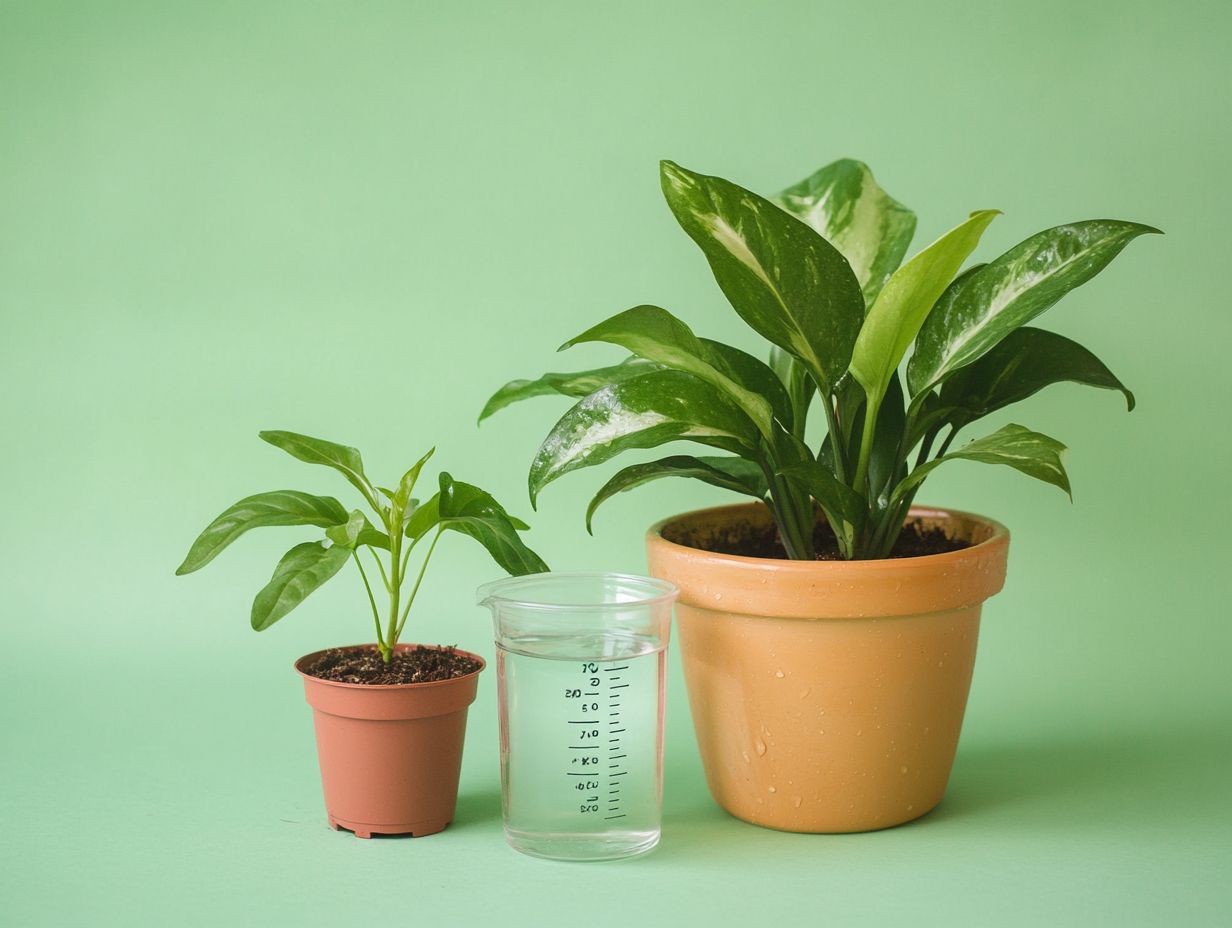
- Pick the right pot size to maintain proper watering. Small pots dry out quickly, requiring frequent watering, while larger pots hold moisture longer.
- Consider factors like plant type, root system, and climate when selecting a pot size. The pot material and drainage holes greatly impact watering needs.
- Use proper watering techniques for different pot sizes, such as self-watering planters. Smaller pots may need more frequent watering with less water, while larger pots might require deeper and less frequent watering.
How Pot Size Affects Watering Needs
The size of your pot plays a pivotal role in determining how often you need to water, as it directly influences water retention and the type of soil or media you choose.
Larger pots typically provide ample volume for water, accommodating various soil types from heavy loams to lighter mixtures like cactus soil. This diversity can significantly alter moisture retention.
Smaller pots tend to dry out more rapidly, often requiring you to water more frequently. This is especially true for thirsty indoor plants like peace lilies or container plants such as petunias, which thrive better in well-draining mediums.
It s essential to consider how these factors interact. For example, a well-draining medium in a large pot might leave roots drier than expected, while compacted soil in a smaller pot could lead to overwatering. By grasping these dynamics, you can cultivate healthier plants and implement optimal growth strategies.
Choosing the Right Pot Size for Your Plants
Selecting the ideal pot size for your plants is a nuanced decision, shaped by factors such as the plant’s growth rate, root structure, and the visual harmony of your indoor garden. This is especially important when grouping plants for maximum visual appeal.
A thoughtfully chosen pot fosters optimal growth and elevates the aesthetic appeal of your space. Therefore, weighing economic considerations and pot material options, including choices like ceramic pots and terracotta, is essential during this process.
Have you found the perfect pot for your plants? Share your tips in the comments below!
Factors to Consider

When selecting the ideal pot size, several critical factors demand your attention, including pot material, drainage holes, and the desired moisture movement to prevent root rot. Understanding how these variables interact, including temperature and humidity effects, can significantly enhance your plants’ health.
For instance, materials like terracotta offer excellent breathability. This helps regulate temperature and prevents overheating especially important in warmer climates with higher evaporation rates. In contrast, plastic pots may retain heat and moisture. While they suit certain plants, they can introduce challenges, such as humidity issues that lead to root rot.
Drainage holes are essential; they prevent root rot by allowing excess water to escape. This strikes the right moisture balance and ensures optimal growth. A ceramic pot with drainage, especially one with thick walls, cools down slowly and retains moisture without causing root problems. Get ready to watch your plants thrive with this perfect moisture balance!
Watering Techniques for Different Pot Sizes
Implementing effective watering techniques tailored to different pot sizes is crucial for ensuring your plants flourish. Various strategies can help optimize moisture control and encourage healthy root growth, particularly when using self-watering planters that prioritize convenience.
By focusing on these methods, you ll cultivate an environment where your plants can truly thrive.
Best Practices for Small Pots
When caring for small pots, mastering effective watering techniques is essential for moisture control. This helps combat higher evaporation rates and maintains a stable environment for your plants to flourish.
For plants in limited soil space, the stakes are even higher; roots can dry out quickly if not carefully monitored. To strike that delicate moisture balance, check the soil every few days and adjust your routine based on temperature and humidity levels.
To optimize water retention, consider using bottom watering. Simply place your pots in a shallow tray of water, allowing the soil to soak up moisture gradually. Choosing a potting mix designed to retain water can enhance your efforts.
Herbs, succulents, and small flowering plants thrive under these tailored strategies, ensuring vibrant growth while steering clear of over-saturation.
Best Practices for Large Pots
For watering large pots, adopting best practices is crucial for ensuring nutrient availability and maintaining optimal temperature regulation, both essential for supporting larger plants and their root systems.
To manage moisture levels effectively in your large pots, regularly assess the soil’s dampness. You can easily do this with a simple finger test, moisture meters, or by assessing soil types to determine the best watering approach. This hands-on strategy allows you to tailor your watering frequency precisely to your plants’ needs and the climate conditions.
Large containers benefit from air pruning. This technique encourages healthier root systems by naturally trimming roots that reach the pot’s edges, enhancing nutrient availability and growth rate. Not only does this promote robust growth, but it also enhances nutrient absorption, ensuring your plants remain vigorous and resilient.
Common Mistakes to Avoid

Avoiding common pitfalls like overwatering and underwatering is essential for mastering your plant care routine. Finding the right balance is key to your plants’ growth and health.
Overwatering and Underwatering
Overwatering and underwatering are common challenges that can have serious repercussions on your plants’ health, leading to issues like root rot and stunted growth.
Recognizing the signs of these water-related problems is essential for anyone passionate about plants. This is particularly true when it comes to maintaining the right moisture control in your pots.
With overwatering, you might notice yellowing leaves, wilting even when the soil feels wet, and a moldy surface around the roots. On the flip side, underwatered plants often show brown, crispy leaf edges, drooping foliage, and soil that feels bone dry.
To keep these issues at bay, maintaining consistent moisture levels is key. Practical steps you can take include:
- Adjusting your watering habits with the changing seasons
- Using well-draining soil to prevent water pooling
- Employing moisture meters simple devices that measure how wet the soil is to keep an eye on soil conditions
By observing your plants closely and responding to their needs, you can significantly enhance their resilience and overall vitality. Act now to ensure proper watering techniques are followed throughout the seasons!
Finding the Perfect Balance for Your Plants
Finding the perfect balance for your plants requires a good understanding of their unique watering frequency needs. This greatly influences their growth rate and overall health in different pot sizes.
You’ll need to examine several factors, including the type of plant, the soil composition, and the size of the pot it’s in. Different plants have distinct water requirements; for example, succulents flourish with infrequent watering because of their ability to hold water, while tropical plants often crave a more consistent level of moisture. To ensure you’re meeting these needs, refer to the understanding watering depth for potted plants.
Soil type is equally essential well-draining soils require more frequent watering compared to heavy, clay-rich varieties that hold onto moisture. This is particularly important for container plants and hanging planters.
Pot size impacts evaporation rates. Larger pots usually keep moisture longer than smaller ones.
To maintain optimal moisture levels, consider using moisture meters, adjusting your watering schedule with the changing seasons, and employing techniques like mulching to help retain soil moisture for better plant growth.
Frequently Asked Questions
How does the size of a pot affect the watering needs of a plant, including aspects like drainage holes and water retention?

The larger the pot, the more soil it can hold and therefore the more water it can retain. This means that larger pots will generally require less frequent watering compared to smaller pots.
What is the recommended pot size for indoor plants and those with high watering needs?
Plants that require frequent watering, such as tropical plants, should be planted in larger pots. This ensures they have enough soil and water to thrive, helping to prevent the soil from drying out too quickly.
Do different types of plants, like succulents versus annuals, have varying watering needs based on pot size?
Yes, each plant has its own unique watering requirements. Some plants may do well in smaller pots with less frequent watering, while others may need larger pots and more water. It is important to research the specific needs of your plants.
Can using the wrong pot size, such as plastic pots versus ceramic pots, affect the health of a plant?
Yes, using a pot that is too small can cause the plant to become root-bound, leading to stunted growth and nutrient deficiencies. Conversely, a pot that is too large can result in over-watering and root rot.
Are there any other factors, such as temperature impact or soil types, that can affect watering needs besides pot size?
Yes, other factors such as the type of soil, humidity levels, and the amount of sunlight can also impact the watering needs of a plant. It is crucial to consider all of these factors when determining the appropriate pot size for a specific plant.
How can I tell if my plant needs to be watered based on the pot size and moisture control techniques?
To find out if your plant needs watering, check how wet the soil is. Stick your finger about an inch into the soil. If it feels dry, it’s time to give your plant some water!
If the soil is still wet, you can wait before watering again. Keeping your plant healthy is rewarding, so stay attentive to its needs!

